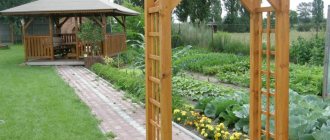There are perhaps no flowers more beautiful than roses. What if this is a stunning arch of roses, which is covered with bright glossy leaves and charming fragrant flowers all season long? Your plot turns into a fairy garden. Arches for roses can be placed above paths, above a passage in a hedge of hydrangeas or barberries, or decorate the entrance to a house or terrace. In any case, it will be a spectacular design that will attract the eye. Many varieties can bloom for a long time, some in two or three waves, but even at a time when there are only leaves on the shoots, the decorative appearance is preserved.
Arches of roses: choosing a variety
To begin with, discard all varieties of roses whose winter hardiness does not suit your climate. Some of them have thick shoots that are difficult to lay, which means that with low winter hardiness there is a high risk of freezing.
- Plant height. This indicator completely depends on the effect you intend. The higher the rose arch, the longer the shoots are needed to completely hide the structure.
- Bloom. The period when the arch becomes the center of the landscape composition depends on the time of flowering. When flowering in waves, roses should be combined with other ornamental plants and shrubs, which can be emphasized during the period when the rose is resting.
- Flower size. For a small arch, varieties with bouquet blooms or medium-sized flowers are more suitable. Of course, it all depends on personal preferences and the design of the site, but huge bushes with lush flowers look better on massive structures.
DIY rose support options
Metal support option for climbing roses
Just tie a few metal rods together with wire and enjoy. Of course, it would be better to paint them.
Options for simple metal supports from the rose garden of the Russian Academy of Sciences.
Options for wooden supports for climbing roses
Grates are most often made from wood and are mounted on metal, concrete or wooden poles. This is the easiest way to raise a climbing rose and has many options in color, size, trellis spacing, etc. It all depends on your imagination and carpentry skills.
To make a grate with your own hands you will need: 1 person who knows how to hold a tool in a crayfish, 1 screwdriver, slats, paint or wood impregnation, wood screws, beams.
Which roses to choose for the arch
There are many varieties on the market, it is quite difficult to understand them. For arches, the most beautiful varieties with long shoots are usually chosen.
- Ramblers. This is the tallest variety. The length of the shoots can reach 5-7 meters. The small size of the flowers is compensated by the incredible number. There are from 15 to 80 flowers in one brush. The typical color scheme for ramblers is from burgundy to white; there may be purple shades. Flowering is observed on last year's shoots. Most varieties are characterized by one wave, but very abundant and long-lasting. Prominent representatives of this type of rose are Blue Rambler, Rambler Red, Crimson, Albrighton, Utigord faiis rose (Utigord Falls)
- Climbers or large-flowered climbing roses. This variety captivates with its huge fragrant flowers and the ability to bloom 2-3 times per season. The plant has a more modest size, the length of the shoots is up to 3 meters. The most attractive varieties are Handel, Red Eden, Rosarium Utersen,
- Roses of Cordes. The most unpretentious varieties with continuous flowering from early summer to mid-autumn. The height of the bushes is no more than 2.5-3 meters. This is the most resilient species, capable of growing in the sun and partial shade. The most successful varieties are considered to be Harlequin, White Sunrise, and Alchemist.
Interesting ideas in landscape design
A large selection of colors, a variety of buds in size and degree of terry, allows landscape designers to create unique and inimitable flower arrangements with climbing roses.
Hedges
Planting roses as a hedge will not only make your garden plot attractive, but will also help hide a nondescript fence. If there is no fence on the site, then for additional support for the roses, a mesh is stretched or a wooden lattice is installed. Planting roses as a living fence is suitable for small areas.
Attention: to make the living fence dense and beautiful, the seedlings are planted close to each other.
Arches
This method of decorating landscape design is the most popular and widespread among gardeners. Arches can be placed at the entrance to the yard, near the house, in the garden. The materials for their manufacture can be:
- metal;
- tree;
- plastic.
Important : if the area is small in size, it is enough to place one arch decorated with climbing roses.
In addition to traditional semicircular arches, you can build rectangular pergolas.
Arch of roses: how to make
If you decide to make an arch for roses, you need to consider the potential of the plant you have chosen. Ramblers will require a serious structure that can support a lot of weight. The fact is that the plant quickly grows a large green mass. In strong winds and after rain, the load on the support can be significant. As a material for any roses, it is better to use a metal rod with a smooth surface with a diameter of 5-8 mm. Connect two to four arcs with each other using pieces of rod equal in length. Naturally, the best fastening would be welding. You can buy a ready-made decorative arch, which will be beautiful even in winter. It is better to avoid wooden structures. They are short-lived; with poor ventilation, fungal spores can develop on the surface of the wood, and pests will overwinter in the cracks.
Climbing rose propagation
There are 5 ways to propagate climbing roses:
- seeds;
- cuttings;
- layering;
- root division;
- grafting (budding).
Cuttings
Cuttings of roses
This method of propagation always gives 100% results. Cuttings are cut in summer, spring or autumn (during pruning). Faded and flowering shoots are suitable for harvesting. How to propagate a climbing rose by cuttings:
- In summer, spring or autumn, cut cuttings 15 cm long from semi-lignified shoots. Leave 2-3 internodes on each.
- Cut the bottom of the cutting at an angle of 45°, 5 cm away from the bud. From above, 1 cm above the bud, make a cut at an angle of 90°.
- Remove the lower leaves completely, cut the upper leaves to half.
- Fill the pots with a mixture of disinfected sand, peat, humus (1:1:1). Deepen the cuttings by 2 cm. Cover with a jar or plastic wrap.
- Place the containers in a room with a temperature of +23...+25 °C, shade them from direct sunlight.
- Ventilate and water the seedlings periodically.
- After 2-3 weeks, remove the jar (polyethylene).
- According to the optimal time for planting roses for your region, transplant the young plants to a permanent place. Care for them as for mature bushes.
Budding
Step-by-step budding
Climbing roses are grafted onto rose hips. The first plant acts as a scion, the second as a rootstock. The procedure is carried out in the second half of July or early August. Before grafting, the rosehip is watered generously with warm water. How to propagate a climbing shrub by budding:
- Make a T-shaped cut on the root collar of a 3-year-old rootstock and slightly pull back the edges of the bark.
- Cut off the bud (eye) from the scion along with the bark and a small piece of wood.
- Insert the bud into the cut in the rootstock, press it tightly, and wrap it with budding film.
- Hill up the rosehip bush so that the soil covers the grafting site by at least 5 cm.
- After a month, loosen the film, and in the spring, remove it completely.
- For the first year, do not let the grafted rose bloom; cut off the buds that appear.
- Care for the grafted plant as you do for others: water, fertilize, mulch, cover for the winter.
Growing from seeds
Disinfection of rose seeds
To propagate climbing roses using this method, purchase high-quality, treated seed material from the store. It is not recommended to collect seeds yourself. Plants obtained from them will not bear the varietal qualities of the mother bush. How to grow a climbing rose from seeds:
- In mid-late February, fill the seed with 3% hydrogen peroxide.
- After half an hour, take it out and place it between 2 sponges soaked in the same substance. Wrap the resulting “sandwich” in plastic and place it in the refrigerator in the vegetable compartment.
- Inspect the seeds from time to time. If mold appears, wash them, replace the cotton pads with new ones (also moistened with hydrogen peroxide).
- After 40–50 days, plant the sprouted seeds in plastic cups with soil mixture for roses, deepening them by 1 cm. Cover with film and place on the windowsill.
- Open the polyethylene daily for ventilation, and after sprouting, remove it completely.
- As the soil dries out, water the seedlings.
- In spring, take the cups outside and place them in a lighted place protected from the wind.
- After 2 months, buds will appear on the seedlings, which need to be removed.
- In April - May, prepare the holes and transplant the young plants to a permanent place. After planting, care for them like mature bushes.
Reproduction by layering
Scheme for propagating roses by layering
How to propagate a climbing rose by layering:
- In the spring, after removing the shelter for the winter and pruning, make a small cut above the bud of one of the shoots.
- Dig a ditch next to the bush, 7–10 cm deep. Place a layer of humus at the bottom, and then earth.
- Bend the shoot, place it in the groove, secure it with metal brackets and cover it with soil. Leave the top outside.
- Care for cuttings as you would for adult plants.
- By autumn, a sprout will appear on the shoot, which can already be transplanted. If winters are cold in your region, postpone this procedure until spring.
- Then separate the branch from the mother bush, cut off the cuttings and plant it in a permanent place. Provide the same care as adult flowers.
Arch for roses: choosing a location
If you decide to create beauty in your area, you need to take care of the comfort of the plants. Each variety has its own lighting requirements. This can be a light area or openwork partial shade. It is important to consider that bushes remain in one place for many years. Avoid planting in places where water will drain from the roof or the crown of large trees. Large drops damage the delicate petals, turning a beautiful flower into a pitiful sight. Consider the perspective of tree growth. Even after 10 years, no thick shadow should fall on the planting site.
Diseases and pests
Climbing roses are more often affected by diseases and pests in the following cases:
- poor or lack of care;
- adverse weather conditions;
- contamination of soil or previous crops.
Powdery mildew
- Features: appears in humid hot weather, excess nitrogen fertilizers.
- Signs: Black, brown spots with a yellow border appear on the leaves of the crop, the bush stops growing, and the flowers fall off.
- How to fight: cut off the affected branches and burn them, spray the healthy ones twice with a mixture of 50 g of soda, 40 g of laundry soap and 10 liters of water. The interval between treatments is 7 days.
Black spot
- Features: Occurs in warm weather and heavy rains.
- Signs: Appears as black spots on the leaves that begin to turn yellow and fall off.
- How to fight: Use a 3% solution of ferrous sulfate (30 g of ferrous sulfate per 1 liter of water). The number of treatments is 3, the interval between them is 7 days.
Spider mite
- Features: Sucks juice from the leaf plates of the crop, entwines the branches with a web.
- Signs: Foliage turns silver and then dies.
- How to fight: Against spider mites you need an infusion of 300 g of fresh wormwood and 30 g of dry leaves. Place the ingredients in a wooden container, add 10 liters of water, leave for three days. Spray the mixture over the above-ground part of the crop and the soil around the bushes.
Green aphid
- Features: Sucks juices from leaves, stems and buds of roses.
- Signs: Deformation, drying of green mass and flowers of the crop.
- How to fight: A soap solution is used against aphids. Grind and dissolve 300 g of laundry soap in hot water, cool the liquid. Spray the flowers with the solution every day for two weeks.
Planting an arched rose
We have decided on a place to install the arch, have chosen a variety, all that remains is to plant it correctly. The distance from the arch to the bush should be such that flexible shoots can be easily rolled up. This is approximately 40 cm. Prepare the soil thoroughly. The same is needed for all roses. It should be loose, nutritious, with a lot of organic matter. When planting soil, do not forget to add a tablespoon of superphosphate to each plant. A climbing rose on an arch should always be healthy and attractive; this requires regular watering. What fascinating photos of rose arches can be found on the Internet. But everything is in your power!
Features of combining climbing roses with other plants
Climbing roses in landscape design are beautiful in themselves and do not require additional decoration with other types of ornamental crops. But in order to create colorful and stylish flower beds, they can still be diversified with such neighbors as:
- decorative dwarf shrubs with silver leaves;
- evergreen small plants, for example, fir, pine;
- boxwood, which will give the queen of the garden some piquancy.
Lifehack 3 – Making a support in the form of a tower
Another simple but convenient support for climbing flowering crops, which externally creates the feeling of a tower. It can be made from metal crossbars, but their height must be at least 50 cm.
Step-by-step manufacturing guide:
- dig the reinforcement into the ground, the supports must be buried to a depth of at least half a meter, then the structure will hold securely, it will not fall or bend under the weight of pink shoots and buds, or strong wind;
- connect the tops, the lower parts of the crossbars should be at a distance of 60 cm from each other, the result should be a miniature turret.
- Plant shrubs near the support; under no circumstances should they be encroached on in space, otherwise the stems will interfere with each other, and this will have a bad effect on flowering.
Life hack 5 – Creating a grid
Summer residents who do not have any experience in carpentry should pay attention to lattice-shaped supports. You can make the frame yourself from wooden blocks, and there is no need to purchase new material; the one you have on hand will do.
You must act strictly according to the instructions:
- prepare vertical and horizontal boards, the diameter of the crossbars should vary between 5-6 cm;
- use a saw to make blocks;
- connect them in the form of a lattice, using nails or screws for fastening;
- thoroughly sand the surface of the structure;
- secure the homemade lattice to pre-installed poles, which were dug into the ground at a distance of a meter from each other;
- at the very end, securely fix the structure with self-tapping screws.
All that remains is to paint the support and give it time to dry. Landscape designers recommend choosing a tone for painting the lattice that matches the color of the rosebuds that will be located on it. Green is also considered a suitable shade, then the wooden elements will merge with the foliage and become invisible.
Lifehack 2 – Assembling a trellis mesh
The easiest way is to assemble a trellis mesh; making such a support is quite simple, it does not require large financial costs and a lot of time. An ordinary chain-link or rope version is suitable as a mesh. The material is simply pulled between two supports.
The structure is assembled in stages:
- Select the ideal place on the site where the rose bushes will be planted. The support will look best next to the house, along the fence.
- Determine the distance between the supports, dig holes along the edges in which you need to install support pillars, their diameter is selected taking into account the variety of roses. For large buds and abundantly creeping shoots, you should take solid pipes.
- Securely secure the pillars and fill them with concrete if necessary. Cover with varnish or paint.
- At the final stage, tighten the mesh.
The design in the form of a lattice screen will help to form a beautiful flowering screen from the bush, dividing the garden plot into separate zones. The trellis can be assembled from wooden blocks; it is enough to fasten the vertical bars to the block profile.
It is not recommended to place the trellis very close to the walls of buildings or fences. This is due to the fact that this arrangement disrupts air circulation, and this harms flowering plants. It is necessary to leave a distance of at least 50-70 cm.
Growing technology
When growing climbing roses, you need to pay attention not only to the formation of buds, but also to the length of the vines. Perfection can be achieved if you plant, prune and care for rose bushes correctly.
Planting roses
Before planting, seedlings of climbing varieties are soaked for 24 hours in a solution to develop the root system, then the roots and the entire plant are examined.
Warning! If the stem and root are brown when cut, they cannot be planted.
After pruning, the stems and roots of the future queen of flowers are sprinkled with wood ash.
A good seedling should have 3-5 shoots and strong roots. Any damage to the rose bushes is removed. The preparation rules are shown in the picture.
The climbing rose has special requirements for the soil: lightness, nutrition, and the ability to pass oxygen and water. You can add a little lime. To increase fertility, you can use humus, phosphorus fertilizers, and humus.
Warning! It is prohibited to apply fresh manure when planting rose bushes.
Climbing roses require a 50x50 hole up to 65 cm deep. At least 100 cm between bushes are important requirements for landscape designers. When planting seedlings, it should be taken into account that the root collar should be buried 10-12 cm. You need to dig holes under future supports, as in this photo, so that later during installation you do not damage the root system of the plant.
After planting, the soil around the climbing rose is lightly trampled and watered. Step-by-step instructions for planting roses to create a landscape design in a garden or country house are presented in the photo.
Further care for climbing roses is traditional: watering, fertilizing, pruning and preparing rose bushes for winter. Flower growers who have been working with climbing varieties for a long time do not always remove the vines from the support and bend them to the ground. Sometimes queens of the garden can spend the winter as in the photo.











